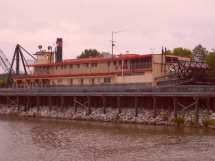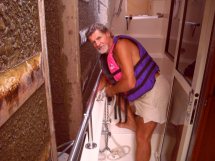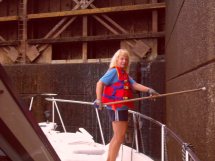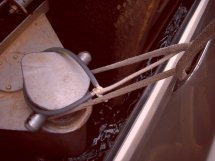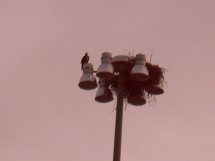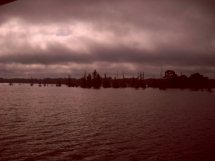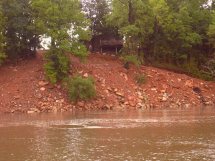There is a rhythm to the daily river
cruising. First, scan for logs, small boats, and
other obstructions. Get an eye on the next marker buoy and line up
for it. Check the depth. Double check the chartplotters for
position. Check the paper chart book for previous notations of rocks,
stumps, and other known hazards. Every once in a while, check the
AIS for commercial traffic in the area. Stop all these when a VHS call
comes through, especially from a tow boat captain reporting his position.
Or the lockmaster talking to approaching vessels. We like to run our 6k
cruise speed, but may have to speed up to make a lock opening if possible.
If we hear of other yachts nearing the lock, we try to go through at the
same time. Commercial vessels have the right-of-way at the locks, and
pleasure craft can wait hours to get through during busy times. The
autopilot does much of the steering, especially on the straight-a-ways.
"Otto" can hold a straighter course. But at the turns, we take over and
steer around them. Saves wear and tear on the autopilot. We love to
anchor out and are always looking for new spots to add to our list. Some
years, we delete anchorages that have shoaled in or disappeared. Several
marinas are on our favorites list, and we usually stop at one along this
Tenn-Tom Waterway. Either Columbus Marina or Midway Marina. Both are
small, friendly spots, have cheap diesel fuel if we need it, and offer loaner
cars. Sometimes we just HAVE to get off the boat and take a walk. It
also give us a chance to wash the river dirt off the boat. Fresh water
cruising means many more bugs and spiders hoping along for a ride. Spiders
cannot survive the harsh sea salt conditions. May Fly invasions are the
worst. Once we wakened to black windows totally covered with them. They
were several inches thick on the decks, too. So far we have not had May
Flies yet.
The day is overcast and cool. We passed through
two locks. We stay outside during the lock thru process to fend the boat
off the wall. We also use many air-filled fenders. By poling off the
wall, this keeps the fenders cleaner and prevents damage to them. The
floating bollards were lower than prior years, and when we looped our line
around it to secure us to the lock wall, it seemed to pull at an odd
angle. Valt was worried it would slip off the bollard and leave
us adrift. But this had never happened, so I was not as
worried. Suddenly the line came off about half way up. Luckily, Valt
had a spare line at the ready and retied it without trouble. He always
keeps a spare line on the steps by the bollard. He also keeps a
knife nearby, if the bollard gets stuck and we have to cut the line.
Talk about prepared. Finally the rains came but were not as violent
as yesterday. Another free boat wash. After we overtook a last tow,
we were heading for the Aberdeen Lock. Bad news. A southbound tow
was already there and they locked him down. Then they waited for the tow
we passed to come and they locked him up. A third southbound tow and barge
was already heading to the lock and they would also be allowed to go
through ahead of us. Total wait time, minimum 2 hours. We dropped
anchor and hunkered down to wait our turn. We had plenty of time to eat
our dinner. This would get us through about 7pm. Just in time to
drop anchor before dark. Lucky we started as early as we did.
As it turned out, we sat at the Aberdeen Lock for 4
hours. The lockmaster was in no hurry to get us through. Until
we were secure in the lock, then he filled the chamber so quickly we could
hardly hold the boat off the wall. We emerged from the lock after 8pm,
just about sunset and had to find our anchorage in the dark. Aberdeen lake is
very shallow, and full of stumps and dead trees. A very treacherous place
if you don't know it. We first tried the Blue Bluff Landing, described in
the guide book. The entrance was shoaled in too much to go in. We
continued up another mile to an arm of the Tombigbee, now a cutoff. There
we anchored for the night with RoBoat, a 44' Hatteras.

